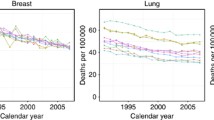Abstract
Introduction: Limited information is available on trends in breast cancer mortality by region of the country.
Methods: Rates for broad age groups were calculated from 1950 to 1999 for whites and 1970–1999 for blacks for four census regions and 508 state economic areas of the United States.
Results: For white women ages 50–64 years, the mortality relative risk [RR] for the Northeast compared to the South was 1.48 in 1950–1959 and 1.15 in 1990–1999. Rates increased in all regions from the 1950s to 1960s but more substantially in the South, increased slightly in the 1970s in all regions, declined slightly in the Northeast, Midwest and West but not in the South in the 1980s, and declined more in the Northeast, Midwest and West than in the South in the 1990s. Among similarly aged black women, the RRs for the Northeast compared to the South were 1.13 and 1.0 in 1970–1979 and 1990-1999, respectively. Among these women, rates increased in all regions in the 1980s; in the 1990s rates declined in the Northeast, Midwest and West but continued to increase in the South.
Conclusion: The historically lower breast cancer mortality rates in the South have been eroded because of relatively less favorable trends in the South.
Similar content being viewed by others
References
Cancer Facts and Figures (2003) American Cancer Society, Inc., Atlanta, GA.
Devesa SS, Grauman DJ, Blot WJ, Pennello GA, Hoover RN, Fraumeni JF Jr (1999)Atlas of cancer mortality in the United States, 1950–1994.Washington DC: US Govt Print Off;[NIH Publ No.(NIH)99–4564].
Sturgeon SR, Schairer C, Gail M, McAdams M, Brinton LA, Hoover RN (1995)Geographic variation in mortality among breast cancer among white women in the United States. J Natl Cancer Inst 87: 1846–1853.
Pickle LW, Mason TJ, Howard N, Hoover R, Fraumeni JF Jr (1987) Atlas of US cancer mortality among whites:1950–1980. Washington, DC: US Gov.Printing Office;DHHS Publ.No. (NIH)87–2900.
Pickle LW, Mason TJ, Howard N, Hoover R, Fraumeni JF Jr (1990)Atlas of US cancer mortality among nonwhites:1950–1980. Washington, DC: US Gov.Printing Office;1990.DHHS Publ.No. (NIH)90–1582.
Chu KC, Tarone RE, Kessler LG, Ries LAG, Hankey BF, Miller BA, Edwards BK (1996)Recent trends in US breast cancer incidence, survival and mortality rates. J Natl Cancer Inst 88: 1571–1579.
Wingo PA, Cardinez CJ, Landis SH, Greenlee RT, Ries LA, Anderson RN, Thun MJ (2003)Long-term trends in cancer mortality in the United States, 1930–1998. Cancer 97: 3133–3275.
Chu KC, Tarone RE, Brawley OW (1999)Breast cancer trends of black women compared with white women. Arch Fam Med 8: 521–528.
Tarone RE, Chu KC, Gaudette LA (1997)Birth cohort and calendar period trends in breast cancer mortality in the US and Canada. J Natl Cancer Inst 89: 251–256.
Marbella AM, Layde PM (1997)Recent trends in breast cancer mortality among white and black US women. Am J Pub Health 87: 775–781.
US Bureau of the Census.US Census of Population:1960, Number of inhabitants, United States summary, final report PC (1)-1A. Washington (DC): US Govt Print Off;1966.
US Cancer Statistics Working Group. United States Cancer Statistics:1999 Incidence. Atlanta (GA): Department of Health and Human Services, Centers for Disease Control and Prevention and National Cancer Institute;2002.
Laden F, Spiegelman D, Neas LM, Colditz GA, Hankinson SE, Manson JE, Byrne C, Rosner BA, Speizer FE, Hunter DJ (1997) Geographic variation in breast cancer incidence rates in a cohort of US women. J Natl Cancer Inst 89: 1373–1378.
Tarone RE, Chu KC (1997)Response.Re:Recent trends in US breast cancer incidence, survival, and mortality rates. J Natl Cancer Inst 23: 1811–1812.
O'Connell M (1981) Regional fertility patterns in the United States:convergence or divergence? Int Reg Sci Rev 6: 1–14.
Friedenreich CM (2001)Review of anthropometric factors and breast cancer risk. European Journal of Cancer Prevention 10: 15–32.
Mokdad AH, Serdula MK, Dietz WH, Bowman BA, Marks JS, Koplan JP (1999)The spread of the obesity epidemic in the United States, 1991–1998. JAMA 282: 1519–1522.
Rock CL, Demark-Wahnefried W (2002)Nutrition and survival after the diagnosis of breast cancer:a review of the evidence. J.Clin Oncol 20: 3302–3316
Schachter JP (2002)Geographic mobility, 1990–1995. Current Population Reports. US Department of Commerce. Economics and Statistics Administration. US Census Bureau.
Goodwin JS, Freeman JL, Mahnken JD, Freeman DH, Nattinger AB(2002) Geographic variations in breast cancer survival among older women:implications for quality of breast cancer care. J Gerontol A Biol Sci Med Sci 57: M401–406.
Farrow DC, Hunt WC, Samet JM (1992)Geographic variation in the treatment of localized breast cancer. NEJM 326: 1097–1101.
Blackman DK, Bennet E, Miller DS (1999)Trends in self-reported use of mammograms (1989–1997)and Papanicolaou tests (1991–1997):Behavioral risk factor surveillance system. MMWR 48: 1–22.
The Dartmouth Atlas of Health Care (1996) Wennberg JE (Series Editor), The Trustees of Dartmouth College, New Hampshire.
Lannin DR, Mathews HF, Mitchell J, Swanson MS, Swanson FH, Edwards MS (1998) Influence of socioeconomic and cultural factors on racial differences in late-stage presentation of breast cancer. JAMA.279:1801–1807.
Hambright TZ (1969)Comparability of marital status, race, nativity and country of origin on the death certificate and matching census record. Vital Health Stat 2:1–47.
Sorlie PD, Rogot E, Johnson NJ (1992) Validity of demographic characteristics on the death certificate. Epidemiology 3: 181–184.
Poe GS, Powell-Griner E, McLaughlin JK, Placek PJ, Thompson GB, Robinson K (1993)Comparability of the death certi cate and the 1986 National Mortality Followback Survey. Vital Health Stat 2: 1–53.DHHS Publ No (PHS)94–1392.
Kircher T, Nelson J, Burdo H (1985)The autopsy as a measure of accuracy of the death certi cate. N Engl J Med 313: 1263–1269.
Percy C, Stanek E, Gloeckler L (1981)Accuracy of cancer death certi cates and its effect on cancer mortality statistics. Am J Public Health 71: 242–250.
Israel RA (1990)Automation of mortality data coding and processing in the United States of America. World Heath Stat Q 52: 259–262.
Rights and permissions
About this article
Cite this article
Sturgeon, S.R., Schairer, C., Grauman, D. et al. Trends in breast cancer mortality rates by region of the United States, 1950–1999. Cancer Causes Control 15, 987–995 (2004). https://doi.org/10.1007/s10552-004-1092-2
Issue Date:
DOI: https://doi.org/10.1007/s10552-004-1092-2




